
16 Results


This course examines the chemical and physical properties of the cell and its building blocks, with special emphasis on the structures of proteins and principles of catalysis, as well as the chemistry of organic / inorganic cofactors required for chemical transformations within the cell. Topics encompass the basic principles of metabolism and regulation in pathways, including glycolysis, gluconeogenesis, fatty acid synthesis / degradation, pentose phosphate pathway, Krebs cycle and oxidative phosphorylation.
Course Format
This OCW Scholar course, designed for independent study, is closely modeled on the course taught on the MIT campus. The on-campus course has two types of class sessions: Lectures and recitations. The lectures meet three times each week and recitations meet once a week. In recitations, an instructor or Teaching Assistant elaborates on concepts presented in lecture, working through new examples with student participation, and answers questions.
MIT students who take the corresponding residential class typically report an average of 10–15 hours spent each week, including lectures, recitations, readings, homework, and exams. All students are encouraged to supplement the textbooks and readings with their own research.
The Scholar course has three major learning units, called Modules. Each module has been divided into a sequence of lecture sessions that include:
Textbook Readings
Lecture Notes or Storyboards
A video by Professor JoAnne Stubbe or Professor John Essigmann
Problem Sets and solutions
To help guide your learning, each of these problem sets are accompanied by Problem Solving Videos where Dr. Bogdan Fedeles solves one of the problems from the set.
- Subject:
- Biology
- Life Science
- Physical Science
- Material Type:
- Full Course
- Provider:
- MIT
- Provider Set:
- MIT OpenCourseWare
- Author:
- Essigmann, John
- Fedeles, Bogdan
- Stubbe, Joanne
- Date Added:
- 09/01/2013

Biology is designed for multi-semester biology courses for science majors. It is grounded on an evolutionary basis and includes exciting features that highlight careers in the biological sciences and everyday applications of the concepts at hand. To meet the needs of today’s instructors and students, some content has been strategically condensed while maintaining the overall scope and coverage of traditional texts for this course. Instructors can customize the book, adapting it to the approach that works best in their classroom. Biology also includes an innovative art program that incorporates critical thinking and clicker questions to help students understand—and apply—key concepts.
- Subject:
- Biology
- Life Science
- Material Type:
- Full Course
- Provider:
- Rice University
- Provider Set:
- OpenStax College
- Date Added:
- 08/22/2012
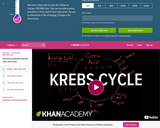
This 18-minute video lesson provides an overview of the Krebs or Citric Acid Cycle. [Biology playlist: Lesson 25 of 71].
- Subject:
- Biology
- Life Science
- Material Type:
- Lecture
- Provider:
- Khan Academy
- Provider Set:
- Khan Academy
- Author:
- Salman Khan
- Date Added:
- 05/18/2012
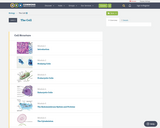
- Subject:
- Biology
- Life Science
- Material Type:
- Unit of Study
- Provider:
- Rice University
- Provider Set:
- OpenStax College

- Subject:
- Applied Science
- Biology
- Life Science
- Material Type:
- Module
- Author:
- Tina B. Jones
- Date Added:
- 08/16/2019

- Subject:
- Applied Science
- Biology
- Life Science
- Material Type:
- Module
- Date Added:
- 07/10/2017
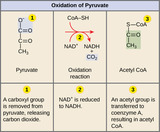
By the end of this section, you will be able to:Explain how a circular pathway, such as the citric acid cycle, fundamentally differs from a linear pathway, such as glycolysisDescribe how pyruvate, the product of glycolysis, is prepared for entry into the citric acid cycle
- Subject:
- Applied Science
- Biology
- Life Science
- Material Type:
- Module
- Author:
- Tina B. Jones
- Date Added:
- 08/16/2019

By the end of this section, you will be able to:Explain how a circular pathway, such as the citric acid cycle, fundamentally differs from a linear pathway, such as glycolysisDescribe how pyruvate, the product of glycolysis, is prepared for entry into the citric acid cycle
- Subject:
- Applied Science
- Biology
- Life Science
- Material Type:
- Module
- Date Added:
- 07/10/2017

In this unit, students look at the components of cells and their functions and discover the controversy behind stem cell research. The first lesson focuses on the difference between prokaryotic and eukaryotic cells. In the second lesson, students learn about the basics of cellular respiration. They also learn about the application of cellular respiration to engineering and bioremediation. The third lesson continues students' education on cells in the human body and how (and why) engineers are involved in the research of stem cell behavior.
- Subject:
- Applied Science
- Biology
- Engineering
- Life Science
- Material Type:
- Full Course
- Provider:
- TeachEngineering
- Provider Set:
- TeachEngineering
- Date Added:
- 10/14/2015

Cellular respiration is the process by which our bodies convert glucose from food into energy in the form of ATP (adenosine triphosphate). Start by exploring the ATP molecule in 3D, then use molecular models to take a step-by-step tour of the chemical reactants and products in the complex biological processes of glycolysis, the Krebs cycle, the Electron Transport Chain, and ATP synthesis. Follow atoms as they rearrange and become parts of other molecules and witness the production of high-energy ATP molecules.
- Subject:
- Life Science
- Material Type:
- Lecture Notes
- Simulation
- Provider:
- Concord Consortium
- Provider Set:
- Concord Consortium Collection
- Author:
- The Concord Consortium
- Date Added:
- 01/13/2012
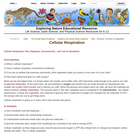
Cellular Respiration Text, Diagrams, Assessments, and Link to Standards
- Subject:
- Life Science
- Material Type:
- Activity/Lab
- Lesson Plan
- Provider:
- Exploring Nature
- Date Added:
- 11/04/2016
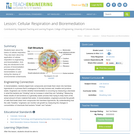
In this lesson, students learn about the basics of cellular respiration. They also learn about the application of cellular respiration to engineering and bioremediation. And, students are introduced to the process of bioremediation and several examples of how bioremediation is used during the cleanup of environmental contaminants.
- Subject:
- Applied Science
- Biology
- Engineering
- Life Science
- Material Type:
- Activity/Lab
- Lesson Plan
- Provider:
- TeachEngineering
- Provider Set:
- TeachEngineering
- Author:
- Janet Yowell
- Kaelin Cawley
- Malinda Schaefer Zarske
- Date Added:
- 09/18/2014

Introduction to cellular respiration, including glycolysis, the Krebs Cycle, and the electron transport chain. Created by Sal Khan.
- Subject:
- Biology
- Life Science
- Material Type:
- Lesson
- Provider:
- Khan Academy
- Provider Set:
- Khan Academy
- Author:
- Sal Khan
- Date Added:
- 12/08/2009

This illustration depicts the first two stages of aerobic respiration: glycolysis and the citric acid cycle.
- Subject:
- Anatomy/Physiology
- Biology
- Botany
- Ecology
- Nutrition
- Material Type:
- Diagram/Illustration
- Author:
- Eunice Laurent
- Date Added:
- 06/10/2022

Overview: glycolysis, pyruvate oxidation, the citric acid cycle (Krebs cycle), and oxidative phosphorylation.
- Subject:
- Biology
- Life Science
- Material Type:
- Lesson
- Provider:
- Khan Academy
- Provider Set:
- Khan Academy
- Author:
- Sal Khan
- Date Added:
- 08/27/2015